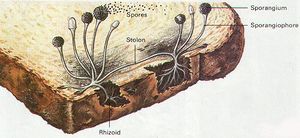Zygomycota

Zygomycota is a Phylum of the Kingdom Fungi. This phylum's name is derived from the method of sexual reproduction used by its members, which involve the creation of zygosporangia and zygospores. Asexual reproduction is possible, but more difficult, so the former is the preferred way to determine the classification of a Zygomycota. [1] There are approximately 900 known species that fall into this Phylum, which composes approximately one-hundredth of all true fungi. It is believed to be one of the earlier branches of fungi, thought to have diverged before plants colonized the lands 600 - 1,400 million years ago. [2]
Identification
Most isolated specimens of Zygomycota do not have zygospores present (due to not currently undergoing sexual reproduction), so generally identification is based on sporangial morphology. Once the fungus matures and establishes itself on a medium, identification is most efficiently done, with emphasis on examination of sporangial morphology. Tease mounts with a drop of 95% alcohol is stated to be quite effective. [4] One particularly common example is Black Bread Mold (Rhizobus stolonifer), which belongs to Zygomycota. [6] Beyond their unique zygospores, Zygomycetes share many characteristics with their true fungi brethren, such as their chitin walls and hyphae, but their mycelia lack septa. [2]
Reproduction
Members of Aygomycota reproduce both sexually and asexually, with differing life phases based on what type of reproduction is to occur. [5] For the former, gametangial fusion occurs and involves the formation of zygospores. The latter involves sporangia. [2] Besides the pros and cons that natively come with both sexual and asexual reproduction, for members of this phylum, zygospores appear better suited for preserving the fungus during times of hardship, while sporangia seem to be better suited for rapid establishment and colonization. [1] The ability to reproduce sexually is a trait that is uncommon among fungi, although it is not exclusive to Zygomycota. [6]
Zygospores and Sexual Reproduction
Sexual reproduction in Zygomycota is similar to the conjugation process that a microscopic organism such as a protozoan might use. To initiate this form of reproduction, certain hyphae called gametangia form a connection and exchange genetic material in nuclei in the center of the connected area. After it accumulates, septa are created to seal off the cell, meiosis creates chromosomes, and the cell where this has taken place grows thick, resistant walls that eventually disconnects. This site becomes known as a zygosporangium, and when the outer layers wear away (allowing the genetic material to be released if ready), it becomes a zygospore. [3] The gametangia used in this process have different "strains", plus and minus. These strains are morphologically similar but differ physiologically and biochemically. [5]
Asexual Reproduction
Asexual reproduction in Zygomycetes is centered on the production of sporangia, which themselves form at the ends of specialized hyphae called sporangiophores. Sporangiospores are formed by internal cleaving of cellular cytoplasm, and eventually the outer walls of sporangia will degrade, allowing spores with the same genetic material of the parent to disperse, aided by natural factors. [2]
Impact on Other Organisms

This Phylum includes many parasitic members; insects in particular can be ravaged by Zygomycetes, but many larger animals (including humans) can become diseased by them, as well as smaller mesofauna, such as Nematodes. Some plants and fungi are also susceptible to infection by parasitic Zygomycetes. [1] However, some invertebrates have Zygomycetes in their digestive tracts, indicating that some members are mutualistic. Zygomycetes are also frequently neutral decomposers. For humans, arguably the main concern that Zygomycetes pose are their presence on spoiling foods, although some species can cause (potentially life-threatening) disease. Those most at risk for this are those with poor immune systems and broken skin. [6] Generally, disease transmission is through the development of spores inside the host, which can range from minor infection (esecially in larger animals) to completely infesting the host and draining it of nutrients, leaving it to die and the Zygomycetes to prepare for further reproduction. However, due to the large range of species (due to Zygomycota being a major Phylum of fungi), the role of Zygomycetes in an ecosystem can vary drastically.
References
[1] "Zygomycota". New Brunswick Museum. Accessed 2018-05-05. http://website.nbm-mnb.ca/mycologywebpages/NaturalHistoryOfFungi/Zygomycota.html
[2] James, Timothy Y. and O'Donnell, Kerry. "Zygomycota". Tree of Life. Accessed 2018-05-06. http://tolweb.org/Zygomycota
[3] "Fungi Reproducing Sexually By Means Of Sporangio and Zygosporangia". New Brunswick Museum. Accessed 2018-05-05. http://website.nbm-mnb.ca/mycologywebpages/NaturalHistoryOfFungi/Sporangia.html#Zygosporangia
[4] "Zygomycota". The University of Adelaide. Accessed 2018-05-06. https://mycology.adelaide.edu.au/descriptions/zygomycetes/
[5] "Fungi - Zygomycota, Conjugating Fungi". Accessed 2018-05-06. http://science.jrank.org/pages/2892/Fungi-Zygomycota-conjugating-fungi.html
[6] "Examples of Zygomycetes." Your Dictionary. Accessed 2018-05-07. http://examples.yourdictionary.com/examples-of-zygomycetes.html